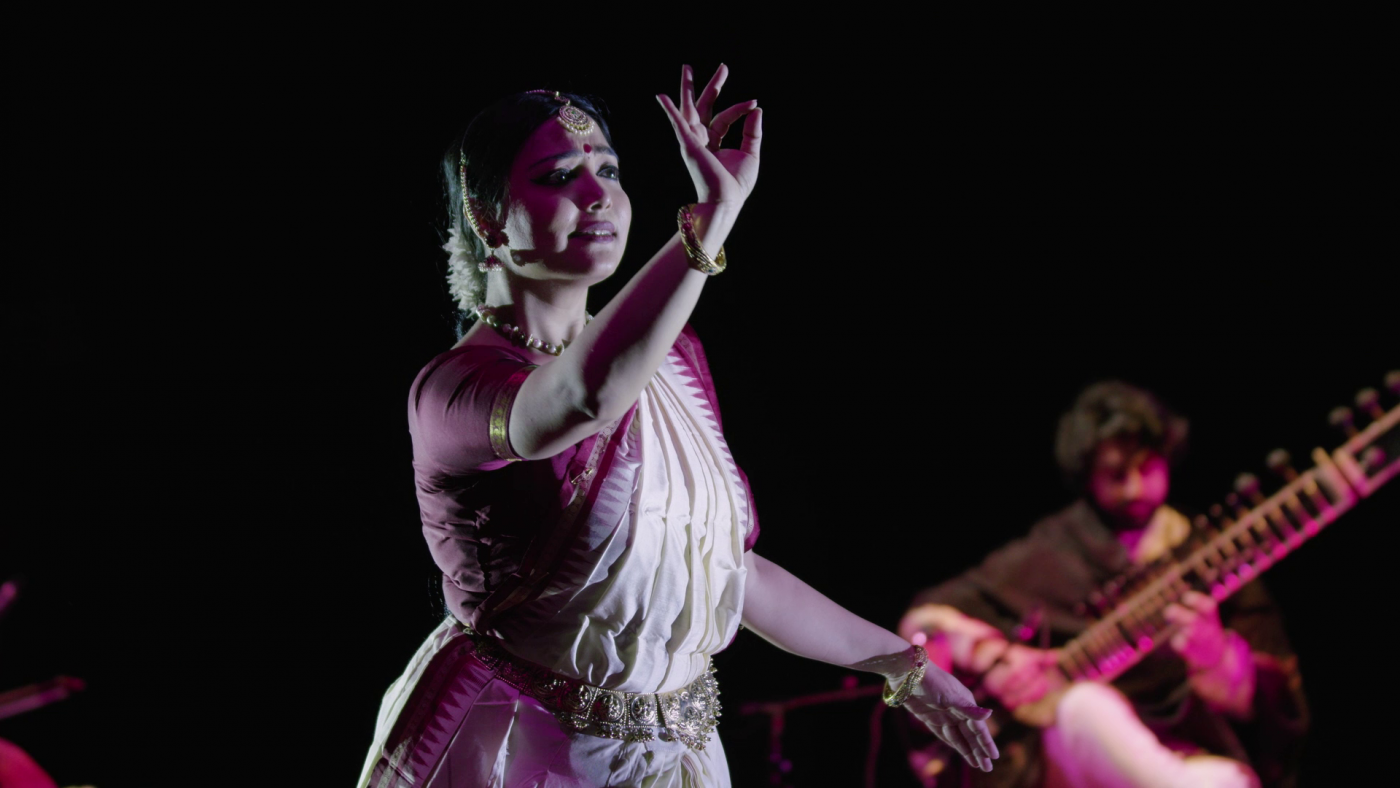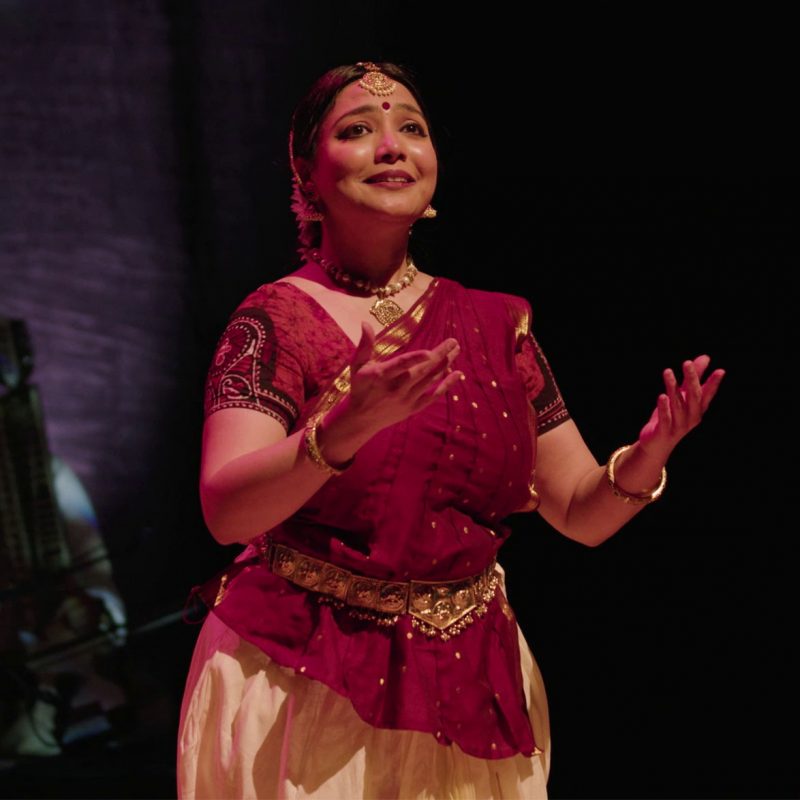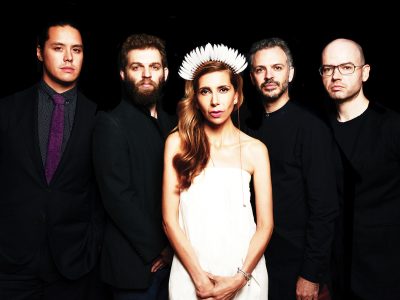- News
- Q & A with Arno Kamolika
Q & A with Arno Kamolika
Arno Kamolika is a Vancouver-based dance artist and co-director of Parāśakti: The Flame Within, part of the 2021 Chan Centre Dot Com Series. Arno’s work seeks non-traditional storytelling through the traditional framework of Bharatanatyam, while she explores her Bengali heritage and skillfully draws from music, theatre, mime and other dance forms to create an informed artistic narrative.
We caught up with Arno to learn more about her background, the impact of the pandemic on her work, and the process of creating Parāśakti: The Flame Within alongside a group of hugely talented artists.

Chan Centre: Hi Arno! Let’s begin with Parāśakti, the inspiration for this piece. The performance has a strong narrative component that centers on the Mother Goddess, with rich characters and vibrant iconographies. Why was it important for you to focus on this story?
Arno Kamolika: The Goddess is a character with various shades in the culture I come from. In Bangladesh, the Mother Goddess is worshipped at their most dreadful form – Kali, who is wild and wanders in the graveyards. The same goddess is also celebrated in their most compassionate form – Durga and Uma, who is a wife and a mother, the daughter of the mother earth, and comes down from Himalaya mountain to visit the land every year. As a young dancer, my early fascination with Bharatanatyam started because the protagonists of the narratives were mostly female. In the abhinaya (narrative) part of Bharatanatyam, the protagonist is always in conversation with another being, whether it is her beloved, child, friend or a divine being. The storytelling brings forward her happiness, pathos, love, jealousy, or struggle—in other words, all the bhava or different states of mind that she experiences in an otherwise patriarchal society. So I was drawn towards this concept of goddess as I thought it would give me a chance to explore different and complex narratives and human emotions that are present in a divine character and bring divinity close to humanity.
CC: The six artists of stage for Parāśakti had never performed together before, and have very diverse backgrounds in the realm of Indian classical music and dance. What was it like working together for the first time?
AK: It was simply joyful and it was a very organic process. When Akhil of ICMSV (Indian Classical Music Society of Vancouver) and Grihalakshmi of Asta Alliance brought the initial idea of the theme of the Goddess to me, we were planning to have a more simple narrative since time was limited for rehearsals due to COVID-19. But when the other artists came on board, their enthusiasm to experiment and collaborate inspired me to create the choreography you’ll be seeing. I believe that irrespective of their different training, all artists are musicians first and they are always there to support each other. For example, if Shrividya was rehearsing a Carnatic raga, Satpreet and Sharanjeet were complementing her with dilruba and sitar in the same way they would do for a Hindustani vocalist. Curtis was playing the mridangam in a way that suits the softness of a Hindustani raga. Akhil was reciting cholkattus like a nattuvanar would do for a Bharatnatyam dancer. We had five musicians with incredibly distinctive skill sets, so we created unique mood for each chapter by focusing on one musician. Some pieces were based on very rigorous Carnatic taalas and swaras, whereas some parts were dilruba or sitar solos following dancer or vice versa.
CC: Your beautiful movement and expressions are so captivating to watch. Can you tell us a bit about your background and training in Bharatanatyam and any specific influences or inspirations that guided your performance here?
AK: Thank you for the kind words. It is particularly important to mention that whatever my body and mind does is the result of the knowledge I have embodied from all my mentors over three decades. My mother, who is a professor of medicine, was also a student of music, and my father is an economist with a deep interest in Rabindranath Tagore’s work on education, society and agriculture. Music and the influence of Tagore’s literature and compositions were always very dominant in our house and also in Chhayanaut, the school I was learning dance from. I trained first in Manipuri, then in Bharatnatyam under my gurus Sharmila Banerjee, Belayet Hossain (Bangladesh), Professor C.V. Chandrasekhar (India), Jai Govinda (Canada) and Bragha Bessel (India). Bragha Bessel has also mentored my choreography for the second chapter of Parāśakti.
Storytelling with music has always fascinated me. I grew up in Dhaka, Bangladesh working in theatre groups, mime productions and playing characters in Tagore dance dramas. But to explore storytelling as a solo dancer, I was mainly inspired by my teachers. Bharatnatyam gave me access to teachers from different ethnicities, who speak different language than me, but I was able to connect with each of them on a very intimate level through this language of dance. When I first saw my teacher Prof. Chandrasekhar performing a solo, a 70-year-old male dance teacher melting into a character of a woman in pathos and captivating a theatre full of audience, I knew this is what I want to learn for the rest of my life. In recent years, my mentors Jai Govinda, Bragha Bessel, and Nova Bhattacharya have been pivotal. My partner Shankhanaad Mallick, who is a scholar of Rabindranath Tagore’s music himself (and who graciously volunteered to be our stage manager for Parāśakti), has been the biggest influence and support in my artistic journey. Most of my ideas come alive when I am in conversation with him doing the most mundane household chores.
"I was nervous and almost terrified at the beginning of this process. I wondered how I would be able to create the narrative of my choreography with all the challenges around COVID-19, and then perform it with live musicians. But our first meeting on Zoom with all our musicians really surprised me. I instinctively knew that this would be a fun ride."
Arno Kamolika


CC: Are there favourite moments or scenes that emerged for either of you as you rehearsed and performed the piece?
AK: There are so many, it is so hard to choose! My favorite scene comes during the middle of the production, when we are trying to seek Goddess Saraswathy in the harmony of nature, set to the beautiful raag Khamaj played by our sitarist. That chapter also inspired the story of the next scene where we are showing deforestation and destruction happening on mother earth. The process of creating this chapter was remarkably interesting. We first came up with a word, “trishna,” which means thirst in bangla. We were trying to create a story to show the thirst of a girl. Akhil proposed raag Pilu for this chapter. My mentor Bragha Akka suggested that we should take some responsibility as humans for the thirst that gets created when a river dries up. That’s when I thought the chapter should start with a tree as the protagonist, not a human. I was trying to create these chapters as a homage to mother earth—and that is where I think the theme of Parāśakti became universal. It was not about a goddess of a specific region anymore. We worked on this very last minute, but I am glad we could show a glimpse of it in the final production.
CC: It is a challenging time in the world in general due to the ongoing COVID-19 crisis, and then there are all the extra considerations needed to safely produce a new work with a collective of musicians. Can you tell us a bit about navigating the creation, development, and performance of this piece during the pandemic? Did anything surprise you?
AK: I was nervous and almost terrified at the beginning of this process. I wondered how I would be able to create the narrative of my choreography with all the challenges around COVID-19, and then perform it with live musicians. But our first meeting on Zoom with all our musicians really surprised me. I instinctively knew that this would be a fun ride. My guess is, because of the isolation we had been experiencing, we all were eager to connect with other artists on a very human level. None of us were worried about the amount of time needed to create. I remember many late night calls and meetings with each artist to discuss a narrative, a raga or a rhythm, as we had limited studio hours. They all were amazingly kind and patient with me. None of us brought a specific expectation to the studio, which helped. All of us were open to challenges and modifications as needed, and the production became richer for that collaborative attitude.
CC: Is there anything else you’d like to share?
AK: I would like to share that the credit of this production goes to the team behind the Chan Centre Dot Com Series, as much as it goes to the artists who have worked on it. The support we received from the people behind the scenes from the first production meeting on Zoom until the days of the recording were amazing. There were several departments working at the same time doing their best to capture our production to its best while keeping all safety protocols in place. The Chan Centre is a lovely theatre—the architecture and interior of the concert hall automatically makes an artist feel something that is larger than life. Although, the empty seats of that huge theatre reminded me the sad reality of not being able to perform this work in front of a live audience. When we finished recording, we were missing the round of applause and energy coming from the audience. But the amazing production team took that sadness away with their warmth and support.
Parāśakti: The Flame Within premieres Friday March 19 at 7pm PST.



